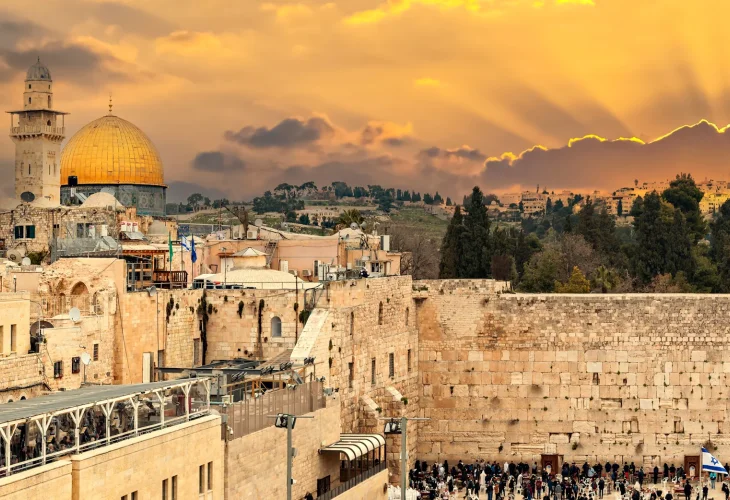The 1929 Riots: A Dark Chapter in Jewish History
The most horrific event took place in the city of Hebron, where 67 Jews, including men, women, and children, were murdered. Many of the victims were students from the Hebron yeshiva. The perpetrators executed their plan with such brutality and monstrosity, recalling only the Simchat Torah massacre of the previous year.
 (Photo: Shutterstock)
(Photo: Shutterstock)The ninth of Av is a time when we are reminded more than ever that the history of the Jewish people tends to repeat itself. In the generations when the Jewish people sinned, they were punished in the month of Av. The Mishnah already mentions events that occurred to our ancestors on Tisha B'Av and the 17th of Tammuz, and, unfortunately, the list has lengthened since then. The expulsion from Spain and other events also took place during Tisha B'Av or the month of Av. One such unfortunate event was the "1929 Riots." In Av of 1929, exactly ninety-five years ago, a wave of violence perpetrated by Arabs spread across the Land of Israel, from north to south.
Shortly before, the party of the Mufti Haj Amin al-Husseini lost the elections for the Jerusalem municipality. Feeling his influence waning, he decided to position himself as the defender of Muslim holy sites. In his sermons and writings, he called on Muslims worldwide to be on alert for the desecration of Islamic holy places by Jews, Zionists, the British, and the rest of humanity.
The Mufti and his supporters opposed Jews praying at the Western Wall, claiming the site was sacred to Islam and that Jews were seeking to take over the Temple Mount and Al-Aqsa. On Yom Kippur of that year, riots broke out, encouraged by the Mufti, further embedding the Mufti's falsehoods in the minds of the Arab masses in the Land of Israel. The Mufti established a high-profile committee of Muslim clerics from around the world. They repeatedly focused on the "Zionist threat" to seize the Temple Mount, creating provocations, publishing incendiary articles, and turning their narrative into a central global issue.
On August 16, 1929, the 10th of Av 1929, a throng of Muslims descended from the Temple Mount mosques to the Western Wall, setting fire to prayer books and notes gathered from the crevices between the stones of the Wall. Later, Jews in the Jerusalem area were attacked, and one Jew was killed. Arab leaders continued to fan the flames, portraying the Jews as aggressors.
On August 22, thousands of rural Arabs from the Jerusalem area gathered at the Temple Mount for Friday prayers. The Mufti explained to the British that the Arabs were armed with knives, axes, and more to repel potential Jewish aggression. By the following morning, the Temple Mount was teeming with thousands of incited Arab villagers. Someone fired a round of shots into the air to incite the crowd further, leading them to march up Prophet Street, looting and vandalizing Jewish homes. Nineteen Jews were killed in this attack. They then headed towards the Mea Shearim and Bukharim neighborhoods, firing into Misgav Ladach Hospital at the entrance to Mea Shearim, injuring Dr. Nahum Korkidi (who recovered and lived many more years).
The following day, the violence spread. Arabs broke into the small Jewish settlement of Motza, killing seven members of the Maklef family. The young child Mordechai Maklef managed to escape, climbing a tree in the yard from where he watched the atrocities unfold as his family was murdered and burned. Mordechai Maklef later became the third Chief of Staff of the IDF.
The most horrific event occurred in the city of Hebron, where 67 Jews, including men, women, and children, were murdered. Many of the victims were students from the Hebron yeshiva. The British officer in the Hebron police, Raymond Cafferata, did nothing to save the Jews from being murdered. The marauders executed their horrifying plan with cruelty and monstrosity reminiscent only of the Simchat Torah massacre of the previous year. The centuries-old Jewish community in Hebron was erased in a single day. Only forty years later did Jews return to Hebron. The nearby settlement of Hartuv, near Beit Shemesh, was also destroyed and has not been resettled to this day.
In the following days, the Jewish community in Safed was attacked. Eighteen people were killed, and eighty were injured. Riots occurred in many other places. The Jews of Tel Aviv managed to fend off the attackers, but they also suffered casualties. The British occasionally arrested the rioters, but often too slowly and hesitantly.
In summary of the horrific events, 133 Jews were murdered, and 339 were injured. Some of the riot leaders were tried and executed by the British. However, the Mufti's malicious plot succeeded. He was carried on waves of admiration in the Muslim public. The myth of "Jews taking over Al-Aqsa" continues to persist to this day, with much bloodshed caused by incited Arabs. Let us hope that the time of our redemption finally comes, and that it will be said enough to all the riots and events.

